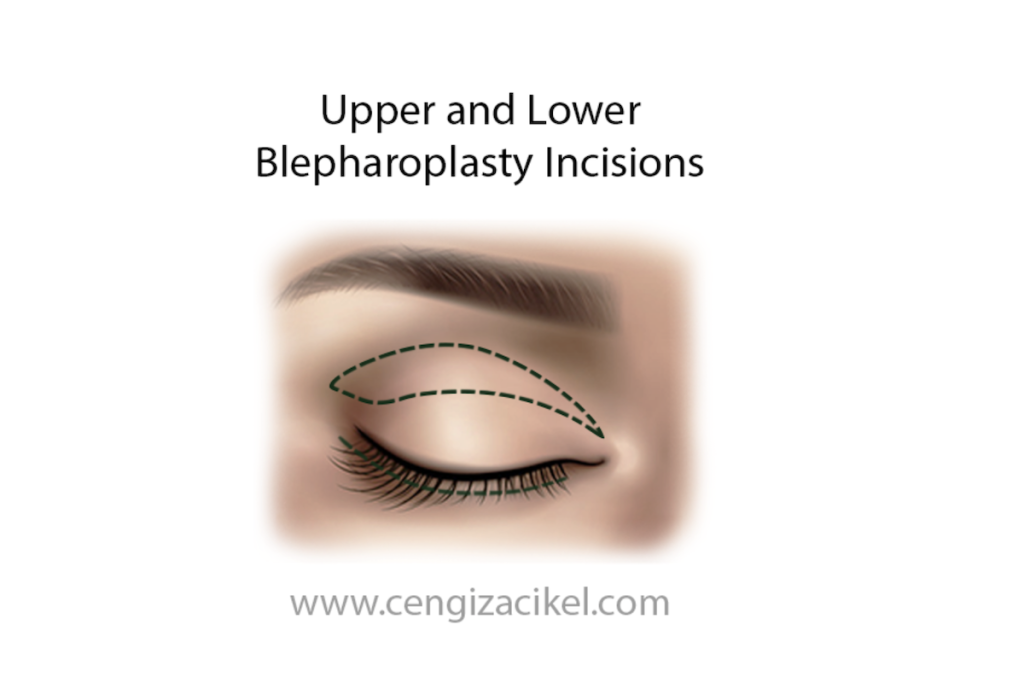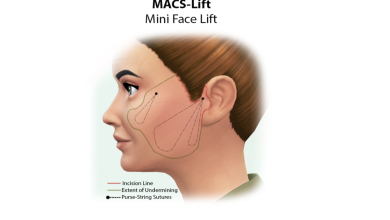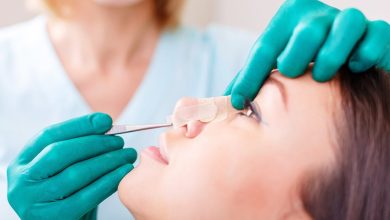What is Blepharoplasty
What is Blepharoplasty (Eyelid Aesthetic Surgery)?
Blepharoplasty, in other words, eyelid aesthetic surgery is a surgical procedure intended for the elimination of aesthetic and functional problems that arise in the form of bags, sags, and wrinkles in the upper and lower eyelids. It is performed under local or general anesthesia by Aesthetic, Plastic and Reconstructive Surgery specialists, under operating room conditions.
Aesthetic appearance of the eyelids and eye contour area has a direct effect on the aesthetic appearance and expression of the face. While sags, baggy eyelids, and wrinkles around these give the person a tired and old appearance, he or she is said “you look tired” etc. or asked questions such as “are you sick?” or “Did you go to bed late last night?” Depending on the changing conditions in business and social life, people’s desire to look rested, dynamic and energetic is increasing with every passing day; and as a result, ”blepharoplasty“, also known as “eyelid plastic surgery” surgery is performed more often.
What Are The Causes Of Eyelid Bags And Sags?
The main causes of eyelid bags and sags, which can be eliminated with aesthetic surgery:
- Aging: It is the primary cause. However, symptoms appear earlier in some people and later in some others. There are many factors affecting this.
- Hereditary and structural causes: Even at a very young age, sagging and bag formation may occur in the eyelids, especially in the lower eyelids, to such an extent that plastic surgery is needed.
- Thin skin structure
- Excessive sun exposure
- Smoking and alcohol use
- Irregular and inadequate sleep
- Stressful life
- Sleeping position (lying face down or without pillow)
- Excessive salt consumption
- Diseases
- Allergies
How is Blepharoplasty Performed?
With a pre-operative examination, problems in the eyelids are revealed. It is evaluated whether the person with the complaint is a suitable candidate for blepharoplasty. it is evaluated whether there are any accompanying aesthetic problems in neighboring structures such as the cheekbones, forehead, and temples, in addition to the problems in the eyelids, and then a treatment plan is made accordingly.
In the pre-operative period, some precautions are started to be taken in order to reduce the risk of both COVID-19 disease and possible complications. If the examinations performed 1-2 days before the operation do not show any problems, the planned operation is performed.
Before the surgery, the sites of the incisions to be made on the upper and lower eyelids are marked. After intravenous sedation, the operation is performed under local or general anesthesia and sterile operating room condition. Additional operations intended to eliminate any accompanying aesthetic problems can also be performed in the same session.
Blepharoplasty is not a monotype, standard surgical procedure. It involves the use of a variety of surgical techniques depending on the degree of the problem in the eyelids. Serious training and experience are essential to be able to accurately identify the problem, correctly determine the surgical technique to be used, and properly perform the operation.
Performing a blepharoplasty operation, i.e. eyelid plastic surgery, takes 1 to 3 hours, depending on the number of eye bags to be treated and the degree of deformation.
Upper Blepharoplasty (Upper Eyelid Surgery)
- Due to the causes stated above, laxity, excess tissues and folds begin to form in the upper eyelid skin and the underlying thin muscle tissue in the course of time. In most cases, the anterior ends of the deeper fat pads, which have the function of protecting the eyeball from shocks and impacts, herniate forward, making the deformation even more prominent.
- The resulting skin fold partially or completely covers the skin of the upper eyelid, which is adjacent to the eyelashes (the part to where women apply eyeshadow).
- The downward displacement of the forehead and eyebrows contributes to this deformation, as well. Advanced cases may require additional procedures such as forehead lift or eyebrow lift for ideal aesthetic results.
- In people with excessive sagging eyelid skin, the opening function of the eyelids becomes difficult and the person needs to keep the eyebrows elevated in order to be able to keep the upper eyelids open, and this may cause wrinkles on the forehead skin. Continuous use of muscles that have the function of raising eyebrows, whether intentionally or unintentionally, can cause headaches.
- Blepharoplasty is performed not only for aesthetic purposes, but also to achieve more comfortable visual function.
Upper Blepharoplasty
- After intravenous sedation, the operation is performed under local anesthesia and sterile operating room conditions.
- The procedure takes about 1 hour but this may vary depending on the degree of deformation and the surgical technique to be used.
- In the same session, the suspension procedure can also be performed on the outer part of the eyebrow through the same incision.
- Upper blepharoplasty can be performed alone or in conjunction with other plastic surgery procedures such as facelift.
- Excess skin and muscle marked before the surgery are removed in the form of strips. If necessary, herniated fat pads are shaved.
- At the end of the surgery, the suture is placed in such a way as to remain hidden inside, the suture line is covered with a thin tape, and the eye is not completely closed to allow vision, albeit limited.
- The tapes are removed four to five days after the operation, and then the patient can take a bath.
- The surgical scar is planned to be positioned in the deepest part of the eyelid, so that it does not attract attention.
Lower Blepharoplasty
- The skin of the lower eyelid and the underlying thin muscle layer loosen and sag. Outward herniation of the deeper fat pads contributes to the deformation called “under-eye bag”.
- Downward displacement of the soft tissues in the cheekbone area just below the lower eyelid due to structural reasons or as a result of aging, cause the formation of a hollow in this area and make the existing under-eye bags more prominent. Therefore, lower blepharoplasty operations mostly involve an additional surgical intervention intended to regain the previous appearance by fill this hollow area for more ideal results. Such a hollow is treated by performing the fat injection, fat pad transfer or midface lift procedure depending on the degree of deformation in the cheekbone. I can say that I don’t perform lower blepharoplasty alone in my own practice. Instead, I combine it with fat filler injection for mild cases and with mini facelift surgery for advanced cases.
- After intravenous sedation, it can be performed under local anesthesia or under general anesthesia if it is combined with other procedures.
- Under the eyelashes, an incision is made that extends parallel to them and exceed a few mm from their margins depending on the situation. The excess skin and muscle are removed in the form of strips. Herniated fat pads (if any) are shaved. The flabby muscle tissue is tightened. In cases where the eyelid skin is excessively loose, additional tightening procedures are performed. In the final stage, deep and superficial sutures are placed and then the operation is ended by applying the tapes.
- In selected cases where the eyelid skin is not loose but there are herniated fat bags, only these fat bag can be removed through an incision made on the inside of the eyelid.
- A lower blepharoplasty operation intended to eliminate under-eye bags takes 1 to 2 hours depending on the extent of the surgical procedure.
- At the end of the operation, the patient may not be able to close the eyelids completely due to edema or the eyelids may seem slightly turned outward, but this condition will improve over time as the edema subsides.
- The patient can return home after the operations performed under local anesthesia, but I prefer to advise all my patients to spend the first postoperative night in the hospital. Thus, it will be much easier and safer to keep the patient in a semi-sitting position, to ensure an appropriate cold application, to monitor blood pressure closely, to administer the necessary antibiotics, painkillers and tranquilizers effectively and safely, and to quickly detect and intervene in any possible problem.
- The superficial sutures are removed after 3 days, and then a supportive tape can be applied to the incision site.
What Are The Dos And Don’ts Before Blepharoplasty?
- Drugs with blood thinning effect that delay blood clotting such as aspirin, vitamins, herbal preparations such as green tea and certain foods should be discontinued at least 15 days before the date of surgery. During the surgical preparation process, our patients are provided with an information form containing more detailed information about this subject.
- Patients with hypertension should definitely take their drugs regularly, and make sure that these drugs adequately control their blood pressure. They should take their blood pressure drugs regularly, including on the morning of the surgery.
- If patients have other eye and vision-related diseases, they should first consult an ophthalmologist to have these disease treated or controlled.
- For the points to be taken into consideration in the surgery process due to the COVID-19 Pandemic.
After Blepharoplasty (Eyelid Aesthetic Surgery)
Postoperative period is important at least as much as preoperative period. First of all, we should act very consciously to avoid possible complications related to the general medical condition, and to detect and treat them in a timely manner, if any. At this stage, it is of vital importance to follow your physician’s advices seriously, and to stay in touch with him/her.
It is often observed that complications develop after some patients do not pay enough attention to the physician’s postoperative recommendations, and push the limits due to various reasons. In the postoperative period, the patient should strictly follow the advice of the physician, even if he/she feels so good and feels no pain.
In the early postoperative period (the first 2 weeks), the following recommendations should be followed in order to reduce the risk of complications in the form of bleeding into the eye, which may even cause loss of vision:
- You should lie on the bed in a semi-sitting position to reduce the facial blood pressure. If possible, you should lie on your back, and avoid lying on your side.
- Especially in the first 2 to 3 days after the operation, cold application to the forehead and cheekbones (without direct pressure on the eyes) for 10 minutes every half hour will reduce the post-operative pain, swelling, bruising, and blood leakage. There is no need for cold application during sleeping.
- You should avoid movements that increase the blood pressure such as straining, lifting heavy things, coughing strongly, and leaning forward.
- Blood pressure should be closely monitored and should not be allowed to rise, and blood pressure drugs should be taken regularly.
- The drugs and nutritional supplements with blood thinning effect, which were discontinued before the surgery, should be avoided for another period of 15 days.
- You should avoid having sex because it increases blood pressure.
- You should be careful not to become constipated.
- You should not consume alcohol and you should not smoke.
- You should avoid taking a bath with extremely hot water.
- The procedure does not cause serious postoperative pain, but if you feel a severe throbbing pain in your eyes and if you have vision problems, you should inform your physician.
Returning to work: You can return to work 1 week after the operation, but it may take 3 to 4 weeks for the edema to completely subside.
In the first 48 hours, edema and some bruising may develop in the surgical areas. From the 3rd day, the edema will begin to subside.
Wearing glasses and lenses: You can wear glasses after surgery. For wearing lenses, you should wait for the edema to subside a bit more, and this takes 2 weeks on average.
Eye dryness: Especially after upper blepharoplasty operations, patients may have complaints due to dry eye that they feel like grains of sand in the eyes. This is temporary, and it is useful to use synthetic tears in the form of eye drops or gels as a support.
Sun protection: In sunny days, it is useful to wear sunglasses and a hat, and to apply a sunscreen with a sun protection factor (SPF) of 40-50 to the incision lines, in order to avoid the formation of stains on the eyelid skin. Active sunbathing should be avoided for one month.
Sports activities: Eyelids should be protected from possible traumas, bumps and blows in the first 6 postoperative weeks. After the first postoperative month, you will be able to start walking and doing non-strenuous light sports. You can swim in the sea and the pool.
Aesthetic appearance: Various degrees of edema and swelling develop on the eyelids after the operation. These edema and swelling do not develop and subside at the same rate in both eyes. Even the position of your head during sleeping at the night will affect the edema. Therefore, it is normal to observe asymmetries and inequalities in the eyelids in the first 1-2 months after surgery. The final result of the surgery appears after 2 months on average.
Incision Scars Although the incision scars on the eyelids are prominent in the first months, they will be unobtrusive by take their final form within 1 to 2 years. Especially in the first 6 postoperative months, you should protect the incision sites from the sun very well by applying sunscreens and other creams recommended to you. You can apply concealer creams on it.
Mental changes: In the first postoperative days, it is very normal to experience a temporary mental depression and feel anxious about the success of the surgery. Trying to make inferences about the result, by looking in the mirror or taking a photo before the edema completely subsides, may sometimes cause unnecessary anxiety. It is normal to observe asymmetries during this period and they are usually due to edema.
Risks and Complications of Blepharoplasty
- Bleeding: In the postoperative period, subcutaneous bleeding in the eyelid skin or bleeding into the eye may occur, and this complication that may even cause loss of vision may require emergency drainage.
- Infection
- Temporary or permanent loss of eyelashes
- Eye dryness:
- Wound dehiscence and delay in healing
- Incomplete closure of the upper eyelid
- The lower eyelid sagging away from the eye (ectropion)
- Change in the eye shape
- Dry eye problem
- Skin incisions that do not heal, remaining noticeable
- Spot formation on the eyelids
- Unsatisfactory aesthetic result
Procedures That Can Be Performed In Addition to Blepharoplasty
Blepharoplasty alone may not be adequate to achieve an aesthetically more ideal appearance in the eyes and eye contour area, so some additional procedures may be required.
- Additional procedures such as laser, radiofrequency or peeling may be required for the elimination of fine wrinkles, sun-damaged appearance and spots on the eyelids.
- Eyebrow lift or forehead lift may be required for the treatment of sagging brows.
- Hollow areas below the lower eyelids may require fat injection or midface lift.
- If there is a general flabby skin problem on the cheeks, a mini or full face lift may be required.
Can Under-Eye Bags Be Treated Non-Surgically?
- Sleeping on a high pillow;
- Avoiding excessive salt consumption;
- Cold compress applications;
- Sleeping regularly and adequately;
- Stopping smoking and alcohol consumption; and
- Treating the allergic conditions, if any, may improve the eye bags to a certain extent.
Does Bleeding Occur After Surgery?
If necessary precautions are taken in both the preoperative and postoperative periods, no noticeable bruise develops.
How Many Hours Does The Operation Take?
It takes 1 to 3 hours depending on the extent of the operations.
Is the Operation Performed Under General Anesthesia?
After intravenous sedation, the operation can be performed under local anesthesia If only blepharoplasty will be performed. If additional surgical procedures such as fat injection are to be performed, general anesthesia is preferred.
Does the Surgery Leave Scars?
When an incision is made on a skin, it definitely leaves a scar. The scars will be prominent in the first months, but they will have an unobtrusive appearance in the following months. Since the skin of the eyelids is thin and loose, the eyelids are among the areas where incisions leave the least noticeable scars.
It is very difficult to notice the scar, especially when the incision is made on the upper eyelid fold. On the lower eyelids, especially in people with dark skin, there may be a noticeable scar due to discoloration that may develop along the incision line. Therefore, adequate sun protection and care should be provided after surgery. You can get more information about the postoperative period at https://en.cengizacikel.com/what-are-the-dos-and-donts-after-plastic-surgery/
How Many Years Does the Result of the Surgery Last? Can Blepharoplasty Be Repeated?
How many years the young and dynamic appearance obtained after blepharoplasty will last depends on the age at which you had the operation, your skin structure and your lifestyle. If necessary, the surgery can be repeated in the following years, but this occurs very rarely.
Blepharoplasty Prices in 2024
The price of the surgery varies depending on which eyelids (upper, lower, both) will be treated and whether additional procedures are required. You can contact our office to find out the treatment procedure appropriate for you and its cost.





